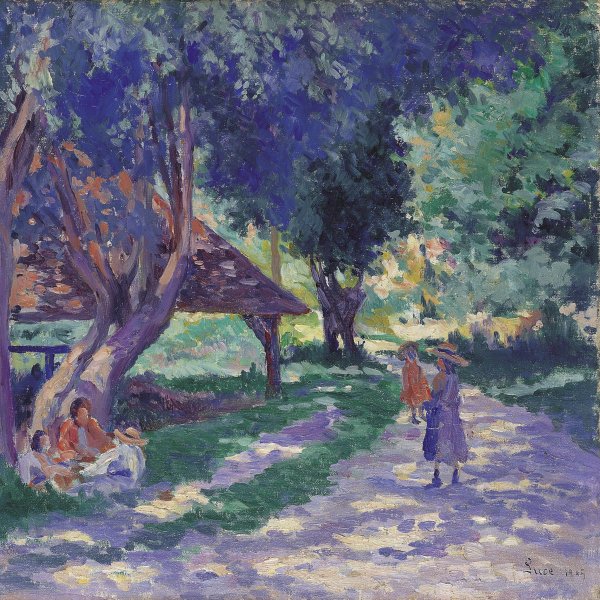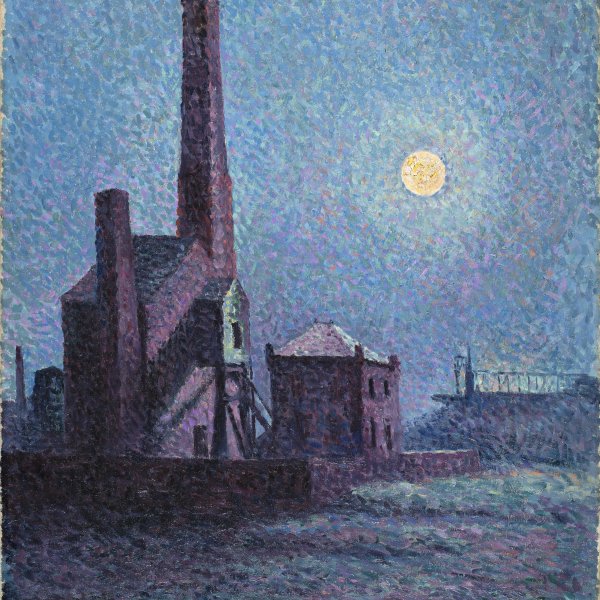Rolleboise, Resting under a Tree
ca. 1925
Oil on canvas.
54 x 65.4 cm
Carmen Thyssen Collection
Inv. no. (
CTB.2000.7
)
Not on display
Level 2
Permanent Collection
Level 1
Permanent Collection
Level 0
Carmen Thyssen Collection and Temporary exhibition rooms
Level -1
Temporary exhibition rooms, Conference room and EducaThyssen workshop
After 1917, as if in an attempt to compensate for the horrors of the war, and thanks to his friend the artist Veillet and to the potter Mettey, Luce visited for the first time Rolleboise, a pretty little village overlooking the Seine between Bonnières and Mantes, not far from Giverny. It was love at first sight between the painter and the village built in terraces on the hillside; at first, Luce rented a room, but soon felt so comfortable there that in 1920 he invested all his savings in buying a little house next to the church, which he depicted many times in his paintings. This marked the beginning of the Rolleboise period, characterised by a large number of views of the village and of its surroundings, taken up and re-composed many times, as if this was the culmination of the painter's entire career.
Here, Luce let his inspiration loose, offering us serene paintings in which Impressionism allowed him to express his sensitivity far from any dictate: there he was more himself. Besides, he never really limited or forced himself to use the device Georges Seurat was fond of. He has always taken up a separate place. Very early on, he abandoned the divided brushstroke which characterised the periods of London, Saint-Tropez and Charleroi, and adopted a wider, freer and therefore more personal style.
In his house perched on the hillside overlooking the Seine, he worked relentlessly, but he rarely painted from nature. Nevertheless, Luce did not confine himself to his studio: he tirelessly went for walks, with a notebook and a pencil in his pocket, striding along the banks of the Seine and in the surrounding countryside, jotting down many sketches on the spot, which he later used for his paintings in his studio.
Luce paid attention first and foremost to shape; colour came after.
In Rolleboise and its surroundings, Luce found a magnificent scenery, which he enjoyed rendering again and again in the changing light according to the weather and the time of the day.
In 1927, Jean Texcier wrote about him in Triptyque-Lettres-Arts-Sciences: "In Rolleboise, Luce painted his most serene and harmonious works, which carry on the great tradition of French landscape painting. They make him the heir of Poussin in the layout and rhythm of his compositions, and of Corot, in that poetry of matter which gives each of his paintings that admirable resonance which affects our innermost feelings."
>br>He put great effort into rendering in his paintings the attitudes of the common people, as he had always been fond of the workers and the peasants. They are the characters who fill his paintings of Rolleboise, in which we see peasants by the Seine. Such is the case of The Entrance of the Village, dated in 1930, in which a carter takes the carriage back to the farm, while a countryman, whose outline conveys at the same time movement and calmness, walks towards the Seine; two figures are resting by the water, emphasising the impression of restraint and tranquility of the whole scene.
Again, it is the quietness of country life which is stressed in this Resting under a Tree of 1925, where the horse and cart depicted facing us convey the impression of a peaceful progression. Luce felt comfortable in the countryside, where he could show more freely his feelings in front of a beautiful tree, whose representation adds to the sense of stability of the whole painting.
In the country, Luce was more easily overcome by emotion. The harshness necessary in the city or in the shipyards he had so often depicted was no longer justified; he no longer needed to hide his sensitivity.
He was moved by the charm of a river bordered with trees, the view of a plain or of a hillside sprinkled with little cottages and farms.
Luce, who had so often represented city life, crowded streets and the labour in the shipyards, now appreciated, with the passing of the years, the agreeable moments spent in Rolleboise. The view of such peaceful scenery suited him; the colours, bright in the past, often enhanced with orange hues, were now usually natural, with a preference for greens, bluish greys and light blues. Such is his The Outskirts of Rolleboise Seen through the Trees. The trees frame the picture, swathing the hamlet in greenery, as if to protect it and reinforce its sense of intimacy and quietness.
Denise Bazetoux
Here, Luce let his inspiration loose, offering us serene paintings in which Impressionism allowed him to express his sensitivity far from any dictate: there he was more himself. Besides, he never really limited or forced himself to use the device Georges Seurat was fond of. He has always taken up a separate place. Very early on, he abandoned the divided brushstroke which characterised the periods of London, Saint-Tropez and Charleroi, and adopted a wider, freer and therefore more personal style.
In his house perched on the hillside overlooking the Seine, he worked relentlessly, but he rarely painted from nature. Nevertheless, Luce did not confine himself to his studio: he tirelessly went for walks, with a notebook and a pencil in his pocket, striding along the banks of the Seine and in the surrounding countryside, jotting down many sketches on the spot, which he later used for his paintings in his studio.
Luce paid attention first and foremost to shape; colour came after.
In Rolleboise and its surroundings, Luce found a magnificent scenery, which he enjoyed rendering again and again in the changing light according to the weather and the time of the day.
In 1927, Jean Texcier wrote about him in Triptyque-Lettres-Arts-Sciences: "In Rolleboise, Luce painted his most serene and harmonious works, which carry on the great tradition of French landscape painting. They make him the heir of Poussin in the layout and rhythm of his compositions, and of Corot, in that poetry of matter which gives each of his paintings that admirable resonance which affects our innermost feelings."
>br>He put great effort into rendering in his paintings the attitudes of the common people, as he had always been fond of the workers and the peasants. They are the characters who fill his paintings of Rolleboise, in which we see peasants by the Seine. Such is the case of The Entrance of the Village, dated in 1930, in which a carter takes the carriage back to the farm, while a countryman, whose outline conveys at the same time movement and calmness, walks towards the Seine; two figures are resting by the water, emphasising the impression of restraint and tranquility of the whole scene.
Again, it is the quietness of country life which is stressed in this Resting under a Tree of 1925, where the horse and cart depicted facing us convey the impression of a peaceful progression. Luce felt comfortable in the countryside, where he could show more freely his feelings in front of a beautiful tree, whose representation adds to the sense of stability of the whole painting.
In the country, Luce was more easily overcome by emotion. The harshness necessary in the city or in the shipyards he had so often depicted was no longer justified; he no longer needed to hide his sensitivity.
He was moved by the charm of a river bordered with trees, the view of a plain or of a hillside sprinkled with little cottages and farms.
Luce, who had so often represented city life, crowded streets and the labour in the shipyards, now appreciated, with the passing of the years, the agreeable moments spent in Rolleboise. The view of such peaceful scenery suited him; the colours, bright in the past, often enhanced with orange hues, were now usually natural, with a preference for greens, bluish greys and light blues. Such is his The Outskirts of Rolleboise Seen through the Trees. The trees frame the picture, swathing the hamlet in greenery, as if to protect it and reinforce its sense of intimacy and quietness.
Denise Bazetoux









